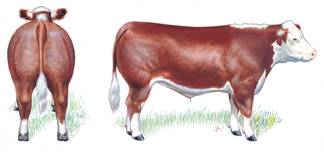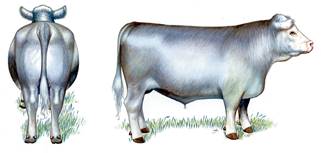Cow-Calf Corner | September 5, 2022
Prepare for Marketing Calves this Fall
Derrell S. Peel, Oklahoma State University Extension Livestock Marketing Specialist
With Labor Day behind us, it is a good time to prepare for marketing calves this fall. The majority of beef calves are spring born, which typically leads to a large fall run of calves. Auction volumes have been larger than usual this summer as the drought in many regions has forced early calf sales. Nevertheless, significant numbers of calves will be marketed before the end of the year.
Weaned calves bring a significantly higher price than bawling calves at auction. Although 30 days is considered a minimum for weaning, buyers strongly prefer calves to be weaned at least 45 days. Recent data and preliminary analysis suggest that weaning periods of 60, 75 and up to 90 days or more bring additional premiums. Longer weaning periods provide more time for calves to recover from the stress of weaning, develop better health and immunity, and to learn to eat from bunks.
Basic calf management such as castration and dehorning were hopefully done at branding, but any late calves missed at branding should be done well ahead of marketing time. Deworming at weaning may also be indicated depending on location and pasture conditions. Two rounds of clostridial and respiratory vaccinations should be given. If calves were vaccinated at branding, a booster can be given at weaning, otherwise vaccinations can be done pre-weaning and weaning or weaning and post-weaning. Vaccination for Pasteurella at weaning is also recommended.
Each of the above practices adds value to calves and the value of all the practices combined in a complete pre-conditioning program is higher than individual practices. Even more value may be captured if calves are enrolled in a certified pre-conditioning program that provides documentation and assurance to buyers that these practices have been properly done. The Oklahoma Quality Beef Network (OQBN) is one such program. Information on the OQBN program. The schedule of upcoming OQBN sales is also found at this website. The 60-day weaning deadline for the early OQBN sales occurs in the next few days.
Typically, calf prices reach the seasonal low around October. However, calf prices have moved counter-seasonally higher this summer as part of a general trend of higher cattle prices. That trend is expected to continue and is reflected in Feeder Cattle futures prices. Table 1 shows Feeder Futures prices for the coming months from October to August 2023. The futures prices show a roughly $14/cwt. uptrend in prices in the next year. When adjusted for Oklahoma City basis (local cash minus feeder futures price), the expected prices for 450- and 750-pound steers for the coming months are shown in Table 1. For example, the November Feeder futures price in Table 1 is $186.20/cwt. The November price of 450-pound steers (M/L No. 1) in Oklahoma City have historically averaged $33.72/cwt. higher than November Feeder Futures (basis) leading to an expected November price of $219.92/cwt. (The combined auction cash price in late August was $211.49/cwt.) Of course, futures prices adjust constantly and there is no guarantee that actual cash prices will match these expected prices. However, futures prices and corresponding expected Oklahoma prices may provide some guidance for marketing plans and expectations and provide the foundation for risk management programs for calves or retained feeder cattle.
| 2-Sep-22 | Nearby Futures: | $183.90 | |||
|---|---|---|---|---|---|
| Futures Month | Feeder Futures | 450 lb. Steers | 750 lb. Steers | ||
| Basis* | Expected Price | Basis* | Expected Price | ||
| October | $185.07 | $23.93 | $209.00 | $0.60 | $185.67 |
| November | $186.20 | $33.72 | $219.92 | $0.79 | $186.99 |
| January | $187.12 | $41.89 | $229.01 | $1.07 | $188.19 |
| March | $189.30 | $48.54 | $237.84 | $3.45 | $192.75 |
| May | $194.00 | $41.67 | $235.67 | $4.34 | $198.34 |
| August | $199.50 | $29.10 | $228.60 | $1.40 | $200.90 |
*2017-2021 average
Retained Ownership? – Part 4 Beef Yield Grades
Mark Z. Johnson, Oklahoma State University Extension Beef Cattle Breeding Specialist
United States Department of Agriculture (USDA) Beef Yield Grades assigned to beef carcasses indicate the percentage of trimmed, red meat yield from the round, loin, rib and chuck of a beef carcass. Beef Yield Grades are based on: 1) amount of adjusted Fat Thickness (external fat) measured at the last rib of the hanging carcass, 2) the percentage of Kidney, Heart and Pelvic (KPH) fat found inside the abdominal cavity of the carcass, 3) the size of the ribeye relative to the 4) hot carcass weight. In short, Yield Grades indicate cutability and are based on the degrees of fatness and muscularity of the carcass. At finishing, heavier muscled, trimmer live cattle will harvest yielding higher cutability carcasses with lower numerical Yield Grades.
USDA Yield Grades from best to worst are:
Yield Grade 1 = highest cutability
Yield Grade 2
Yield Grade 3
Yield Grade 4
Yield Grade 5 = lowest cutability
Yield Grade 1 example
Yield Grade 5 example
With respect to the beef carcass value, USDA Yield Grades do not provide as much economic incentive as Beef Quality Grades. Although there are some carcass value marketing systems (grids) that do give more economic incentive to cutability, it is important to remember that virtually all beef cuts sold at retail are marketed on a closely trimmed (.10 inch or less) basis. Trimming of excessive fat can be done after harvest. Quality Grades based on marbling are a result of growth and development prior to harvest and can’t be “fixed” to the extent which excess fat can be trimmed away. That being said, Yield 4 and 5 fed cattle represent waste and inefficiency in beef production and receive substantial discounts in virtually all grid based marketing systems.
Conclusion
Selection tools in the form of EPDs are available to breeders. Pedigreed seedstock is readily available with predicted genetic values for Ribeye Size, Hot Carcass Weight, Fat Thickness and Marbling Scores. As stated earlier in this series, operations currently making the decision on whether or not to retain ownership through finishing and market fed cattle on a carcass value basis should answer several questions. One of the most important: How much selection pressure have I put on the EPDs influencing carcass value in past bull selection?
Beef Quality Assurance Program Injection Site Guidelines
Bob LeValley, Oklahoma Beef Quality Assurance Coordinator
In order to reduce the incidence of injection site lesions, injectable products should be administered subcutaneous (SQ)if the label allows. Intramuscular (IM) injections not only increase soreness compared to subcutaneous injections, but some products given IM have the potential to cause muscle damage which subsequently causes a significant amount of expensive carcass trim. Knots or blemishes from SQ injections are much easier to find, examine and remove at the packers. Because of these considerations, the national Beef Quality Assurance program adopted a policy that all injections (antibiotics, vaccines, parasiticides, vitamins, prostaglandins, hormones, and all other injectables) be given in front of the slope of the shoulder, that products with SQ labeling be selected in preference to products labeled for IM use only, and that IM injections if required, be limited to not more than 10 cc per injection site.
A Producer’s Guide for Judicious Use of Antimicrobials in Cattle
- Prevent problems: Emphasize appropriate husbandry and hygiene, routine health examinations, and vaccinations.
- Select and use antibiotics carefully: Consult with your veterinarian on the selection and use of antibiotics. Have a valid reason to use an antibiotic. Therapeutic alternatives should be considered prior to using antimicrobial therapy.
- Avoid using antibiotics important in human medicine as first line therapy: Avoid using as the first antibiotic those medications that are important to treating strategic human or animal infections.
- Use the laboratory to help you select antibiotics: Cultures and susceptibility test results should be used to aid in the selection of antimicrobials, whenever possible.
- Combination antibiotic therapy is discouraged unless there is clear evidence the specific practice is beneficial: Select and dose an antibiotic to affect a cure.
- Avoid inappropriate antibiotic use: Confine therapeutic antimicrobial use to proven clinical indications, avoiding inappropriate uses such as for viral infections without bacterial complication.
- Treatment programs should reflect best use principles: Regimens for therapeutic antimicrobial use should be optimized using current pharmacological information and principles.
- Treat the fewest number of animals possible: Limit antibiotic use to sick or at-risk animals.
- Treat for the recommended time period: To minimize the potential for bacteria to become resistant to antimicrobials.
- Avoid environmental contamination with antibiotics: Steps should be taken to minimize antimicrobials reaching the environment through spillage, contaminated ground run off or aerosolization.
- Keep records of antibiotic use: Accurate records of treatment and outcome should be used to evaluate therapeutic regimens and always follow proper withdrawal times.
- Follow label directions: Follow label instructions and never use antibiotics other than as labeled without a valid veterinary prescription.
- Extra-label antibiotic use must follow FDA regulations: Prescriptions, including extra label use of medications must meet the Animal Medicinal Drug Use Clarification Act (AMDUCA) amendments to the Food, Drug, and Cosmetic Act and its regulations. This includes having a valid Veterinary/Client/ Patient Relationship (VCPR).


